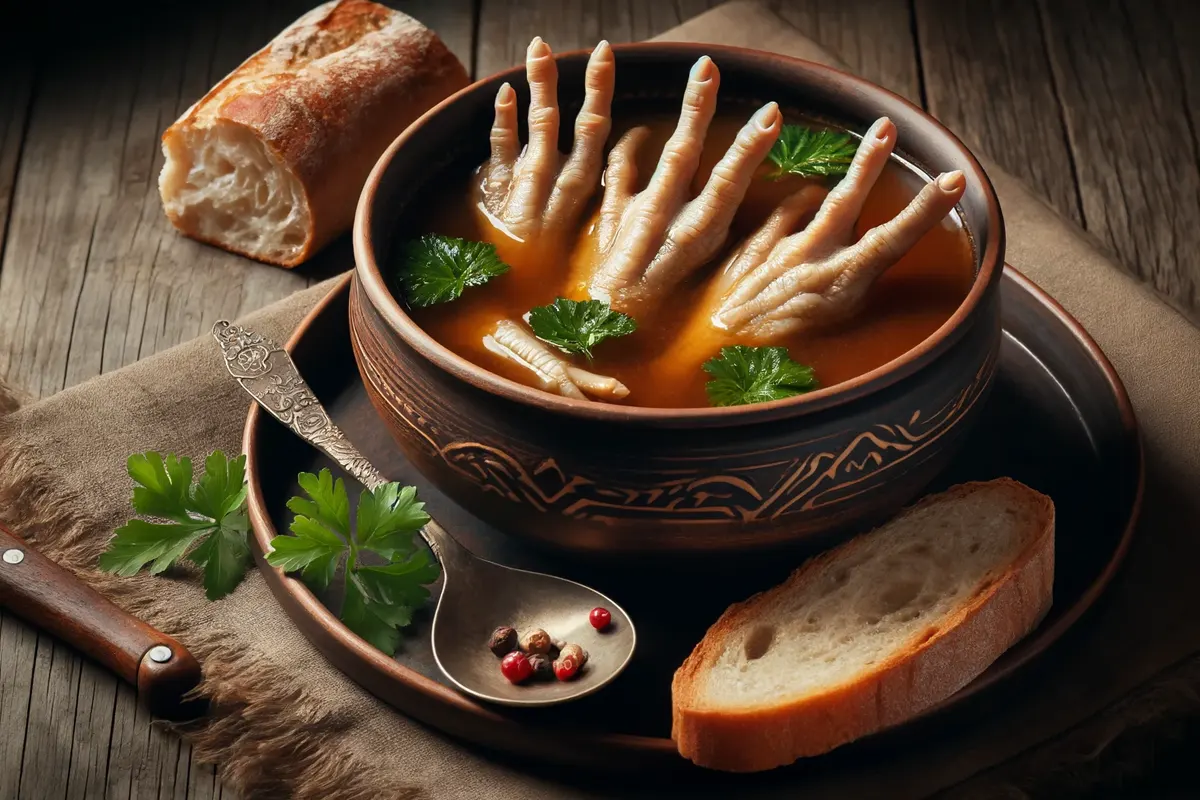Diving into the world of culinary delights, Chicken Feet Soup emerges as a dish brimming with cultural heritage and nutritional value, embodying the interconnectedness of our health with food traditions, as emphasized by the Food and Agriculture Organization of the United Nations FAO. Far from being just another recipe, this soup encapsulates a rich tapestry of traditions, flavors, and health benefits that beckon the curious and the gourmet alike. In this article, we embark on a savory journey, exploring the essence of Chicken Feet Soup – from its roots in various cultures to its preparation and the myriad benefits it brings to the table. So, fasten your aprons, and let’s unravel the savory secrets of this unique broth.
Introduction to Chicken Feet Soup
Ah, Chicken Feet Soup, a dish that might raise eyebrows at first mention but holds a revered place in many a culinary tradition around the globe. You might wonder, “Is chicken feet soup good for you?” Well, buckle up, as we’re about to dive into a pot brimming with flavors, history, and, yes, a hearty dose of wellness.
Overview of chicken feet soup’s cultural significance
Across continents, from the vibrant streets of Southeast Asia to the warm kitchens of the Caribbean, chicken feet soup is more than just a meal; it’s a celebration of culture and community. Each slurp is a story, each sip a journey through generations. In places like Jamaica and China, this soup isn’t just food; it’s a ritual, lovingly prepared and shared with family and friends on special occasions or as a weekend comfort dish.
Brief history and variations across regions
Tracing the roots of chicken feet soup is like following a spice trail through history. While the exact origin might be as elusive as the perfect broth, it’s clear this dish has been simmering in pots for centuries. In China, it’s prized for its collagen-rich content, believed to promote skin health and vitality. Meanwhile, in the Caribbean, it’s a hearty weekend treat, often loaded with dumplings, yams, and a kick of scotch bonnet pepper.
Each region adds its own twist, painting a global mosaic of chicken feet soup variations. From the addition of unique spices in Malaysia to the comforting thickness of the soup in Jamaica, the dish is a testament to the diversity of culinary traditions. Yet, at its core, chicken feet soup remains a humble celebration of an often-overlooked part of the chicken, transformed through the magic of cooking into a broth teeming with flavor and goodness.
So, as we stir the pot and peel back the layers of this intriguing dish, let’s savor not just the taste but the rich cultural tapestry it represents. Stay tuned as we delve deeper into the health benefits, preparation, and culinary secrets that make chicken feet soup a dish worth exploring, one spoonful at a time.

In the world of traditional broths and soups, Chicken Feet Soup stands out not only for its unique ingredient but also for the myriad of health benefits it brings to the table. As we continue our culinary journey, let’s delve into the nutritional treasure trove that this particular soup offers. From its collagen-packed base to the various vitamins and minerals it contains, this soup is more than just comfort food; it’s a bowl of wellness.
Health Benefits and Nutritional Insights
Collagen Content and Joint Health
One of the most celebrated aspects of chicken feet soup is its high collagen content, pivotal for our body. Collagen, a protein pivotal for our body, is lauded for its ability to promote joint health, reduce inflammation, and enhance skin elasticity. As we age, our body’s natural collagen production declines, making chicken feet soup an excellent dietary addition to help replenish these vital levels. So, the next time you savor a spoonful of this hearty soup, remember, it’s not just warming your soul but also nourishing your body.
Nutritional Profile of Chicken Feet
Chicken feet themselves are a powerhouse of nutrients. Packed with protein, calcium, and phosphorus, they contribute to bone health and regeneration. Moreover, the soup’s base, often enriched with vegetables like carrots, potatoes, and onions, adds a boost of vitamins A, C, and K, along with fibers and antioxidants. This nutrient-dense concoction supports immune function, aids digestion, and combats oxidative stress, making chicken feet soup a well-rounded dish for overall wellness.
It’s fascinating to see how a dish as simple as chicken feet soup, often overlooked or considered a culinary oddity, can be a source of such profound health benefits. By embracing traditional recipes and the wisdom passed down through generations, we uncover natural, holistic ways to support our health and well-being. As we move forward, keep in mind that this soup is more than just a treat for the taste buds; it’s a gesture of care for the body and spirit.
In our next section, we’ll explore the essential ingredients that make chicken feet soup a rich and flavorful experience and provide alternative options for those with specific dietary needs. Stay tuned as we continue to stir the pot, unveiling the secrets of this nutritious and culturally rich delicacy.
As we delve deeper into the heartwarming world of Chicken Feet Soup, it becomes clear that this dish is a symphony of flavors, each ingredient playing a vital role in creating its rich, comforting essence. From the foundational chicken feet to the medley of vegetables and spices, let’s explore the components that make this soup a beloved culinary treasure, along with alternative options to cater to various dietary preferences and needs.

Crafting the Perfect Chicken Feet Soup
Core Ingredients Breakdown
At the core of Chicken Feet Soup lie, of course, the chicken feet themselves, known for their unique texture and ability to infuse the broth with a rich, gelatinous quality thanks to their high collagen content. Complementing the chicken feet is a variety of vegetables that not only contribute to the soup’s nutritional profile but also add depth and complexity to its flavor. Common additions include:
- Pumpkin: Adds a subtle sweetness and vibrant color, along with a boost of beta-carotene.
- Potatoes: Whether sweet or regular, potatoes lend a hearty, comforting element and thicken the broth.
- Carrots: Introduce a hint of sweetness and are a great source of vitamin A and antioxidants.
- Onions and Garlic: These kitchen staples are essential for building the soup’s aromatic base, offering immune-supporting benefits.
Spices and herbs like thyme, scotch bonnet pepper, and allspice play a crucial role in seasoning the soup, infusing it with traditional flavors that are both comforting and invigorating.
Alternative Ingredients for Dietary Needs
Understanding the diverse dietary needs and preferences, Chicken Feet Soup can be easily adapted with alternative ingredients. For those avoiding nightshades, sweet potatoes can be replaced with turnips or parsnips. If you’re looking to reduce the soup’s carbohydrate content, consider using cauliflower florets as a potato substitute.
For vegetarians intrigued by the health benefits and flavors of this type of soup, while the specific ingredient of chicken feet is irreplaceable in terms of authenticity, you can achieve a similarly nutritious and collagen-rich broth by using a combination of vegetable broth, seaweed, and mushrooms like shiitake. These ingredients offer umami and depth, creating a comforting vegetarian broth that echoes the essence of the traditional dish.
Incorporating these alternatives not only caters to various dietary needs but also opens the door to creativity in the kitchen. By exploring different ingredients, you can tailor Chicken Feet Soup to your taste preferences and nutritional requirements, making it a versatile dish that can find a place in any culinary repertoire.
As we move forward, we’ll guide you through the art of cooking Chicken Feet Soup, providing a step-by-step approach to ensure you can bring this nourishing, flavorful broth to your table with ease. Stay tuned as we continue our culinary journey, embracing the rich traditions and innovative adaptations of this beloved soup.
Embarking on the culinary adventure of making a hearty soup is both an art and a science. This section serves as your compass, guiding you through the meticulous process of transforming simple ingredients into a pot brimming with flavor and tradition. Let’s roll up our sleeves and dive into the step-by-step cooking guide that will illuminate the path to a perfect bowl of hearty soup.
The Art of Cooking Chicken Feet Soup
Preparing the Chicken Feet
The journey begins with the star ingredient – the chicken feet. These may appear daunting at first glance, but fear not! Preparing them is straightforward:
- Start by giving the chicken feet a thorough rinse under cold water.
- Next, clip off the nails using kitchen shears – this is a crucial step to ensure a clean broth.
- To remove any impurities and to blanch the feet, boil them in water for about 5 minutes, then plunge them into ice-cold water. This process also makes peeling the outer layer of the skin much easier, which some prefer for a smoother broth.
Soup Base Preparation
With the chicken feet prepped and ready, it’s time to lay the foundation of the soup:
- In a large pot, combine the chicken feet with ample water or chicken stock to cover them generously. This liquid gold will form the base of your soup.
- Add to this base a hearty selection of root vegetables – think chunks of pumpkin for sweetness and potatoes for body. Don’t forget the aromatic trinity of onions, garlic, and thyme, which will infuse the broth with deep, savory notes.
- For a touch of heat and flavor, a whole scotch bonnet pepper can be added. Remember, keep it whole to moderate the spice level.
Combining Ingredients and Simmering
With the base aromatic and simmering, it’s time to bring all the elements together:
- After the chicken feet have softened and the broth is flavorful, introduce additional vegetables like carrots and corn to the pot. These will add not only nutrition but also varied textures and colors to the soup.
- Dumplings or “spinners” are a traditional addition, providing substance and heartiness. A simple dough of flour and water, rolled into small elongated shapes, is all it takes to make these delightful morsels.
- Continue to simmer the soup, allowing the flavors to meld and the broth to thicken slightly, thanks to the natural gelatin from the chicken feet. This is the moment where patience pays off, as a slow and gentle simmer coaxes out every ounce of flavor.
The final step is to taste and adjust the seasoning, adding salt and pepper as needed. Remember, the magic of Chicken Feet Soup lies not just in its ingredients but in the love and care poured into every step of its preparation.
As we move on from the bustling kitchen to the serene moment of serving this nourishing soup, the next section will guide you through the best ways to present and store Chicken Feet Soup, ensuring that every bowl is as delightful as the last. Stay tuned as we continue to explore the warmth and comfort this traditional dish has to offer.
After the loving labor of simmering and seasoning, your Chicken Feet Soup is now a steaming pot of comfort, ready to be served. This part of the journey focuses on presenting this heartwarming dish in a way that honors its rich flavors and on preserving any leftovers for future enjoyment.
Serving Suggestions and Preservation Tips
Ideal Accompaniments
Chicken Feet Soup is a meal in itself, brimming with nutritious ingredients and bold flavors. To complement its richness, consider serving it with simple, light sides. A fluffy, freshly baked bread or a delicate serving of steamed rice can balance the soup’s robustness, making each spoonful an experience to savor. Garnish with fresh herbs like parsley or cilantro to add a burst of color and freshness, elevating the dish’s presentation and adding a hint of brightness to its deep flavors.
Storing and Reheating
The joy of Chicken Feet Soup need not end with the meal; with proper storage, you can relish the flavors another day. To store leftovers:
- Allow the soup to cool down to room temperature before transferring it to airtight containers. This prevents bacterial growth and maintains the soup’s quality.
- Refrigerate promptly. Chicken Feet Soup can be safely stored in the refrigerator for up to 3-4 days. Remember, the sooner you refrigerate, the better it retains its taste and nutritional value.
- For longer storage, freezing is an option. Pour the cooled soup into freezer-safe bags or containers, leaving some space for expansion. Frozen Chicken Feet Soup can last for up to 2 months. Note: Consider removing the dumplings before freezing, as their texture might change upon reheating.
Reheating Chicken Feet Soup is best done on the stovetop. Gently warm the soup over low heat, stirring occasionally, until it’s evenly heated through. This method helps retain the soup’s texture and flavors better than microwaving. If the soup has thickened in the fridge, a splash of water or broth can bring it back to its original consistency.
By serving Chicken Feet Soup with care and storing it properly, you ensure that each bowl, whether enjoyed immediately or savored later, is a comforting embrace of flavors and traditions. As we conclude our exploration of this unique dish, remember that it’s more than just a recipe; it’s a celebration of culture, nutrition, and the simple joys of homemade comfort food.

As we’ve journeyed through the world of Chicken Feet Soup, uncovering its rich flavors, nutritional benefits, and the art of its preparation, it’s natural to have questions bubble up. This section is dedicated to answering some of the most frequently asked questions about this intriguing dish, shedding light on common curiosities and concerns.
Expert Answers to Your Frequently Asked Questions
Is Chicken Feet Soup good for you?
Absolutely! Chicken Feet Soup is not only a comfort food but also a nutritional powerhouse. The high collagen content from the chicken feet is excellent for joint health, skin elasticity, and overall wellness. Additionally, the variety of vegetables and spices used in the soup contribute essential vitamins, minerals, and antioxidants, making it a balanced and healthful choice.
How long can you store Chicken Feet Soup?
Properly stored, Chicken Feet Soup can last in the refrigerator for 3-4 days. If you opt to freeze it, ensure it’s in an airtight container, and it can be kept for up to 2 months. Remember, when reheating, it’s best to do so gently on the stove to preserve the soup’s flavors and textures.
Can Chicken Feet Soup be made ahead of time?
Certainly! Chicken Feet Soup is an excellent candidate for meal prep or cooking ahead. If you’re planning to serve it later, simply prepare the soup as usual, allow it to cool, and then store it in the refrigerator until needed. Reheat on the stove, adjusting the consistency with a bit of water if necessary, and it will be as delightful as when it was first made.
By addressing these queries, we hope to have cleared any doubts and encouraged you to embrace Chicken Feet Soup not just as a culinary novelty, but as a nourishing, flavorsome addition to your cooking repertoire. As we wrap up this exploration, let the warmth of the soup and the richness of its heritage inspire you to create, share, and savor the simple pleasures of home-cooked meals.
Conclusion and Call to Action
As our savory journey through the delightful realm of hearty soups comes to a gentle simmer, we find ourselves enveloped in the rich tapestry of its history, nutritional virtues, and the sheer joy of cooking this comforting dish. This exploration has not just been about unraveling the secrets of a unique recipe but about connecting with a culinary tradition that spans cultures and generations, offering us a taste of the world in every spoonful. Embracing the Warmth of Hearty Soups
In retracing the steps from the bustling markets where we select our fresh ingredients to the quiet moments spent stirring the pot, we’ve woven a story of tradition, health, and community. Chicken Feet Soup, with its collagen-rich goodness and medley of nutritious ingredients, stands as a testament to the power of simple, wholesome cooking in fostering well-being and togetherness.
This journey has hopefully ignited in you a curiosity to explore beyond the familiar, to embrace the unconventional, and to find beauty and nutrition in the most unexpected places. Whether you’re drawn to Chicken Feet Soup for its health benefits, its cultural significance, or simply the adventure of trying something new, this dish offers a canvas for culinary creativity and a gateway to global flavors.
A Call to the Culinary Curious
As we part ways at this crossroad of culinary discovery, I invite you to don your apron, wield your ladle, and embark on your own adventure with Chicken Feet Soup. Moreover, let the rich, gelatinous broth be a reminder of the simplicity and nourishment that traditional cooking offers. Furthermore, share this dish with loved ones, celebrate the diversity of global cuisines, and continue to explore the vast world of flavors and stories that every recipe holds.
Remember, every dish has a story, and every spoonful is an opportunity to connect with traditions far and wide. So, go ahead, dive into the pot, and let the comforting embrace of Chicken Feet Soup warm your heart and soul.
As we conclude, I encourage you to share your experiences, your variations, and the tales of your culinary explorations in the comments below. What will your Chicken Feet Soup story be?

